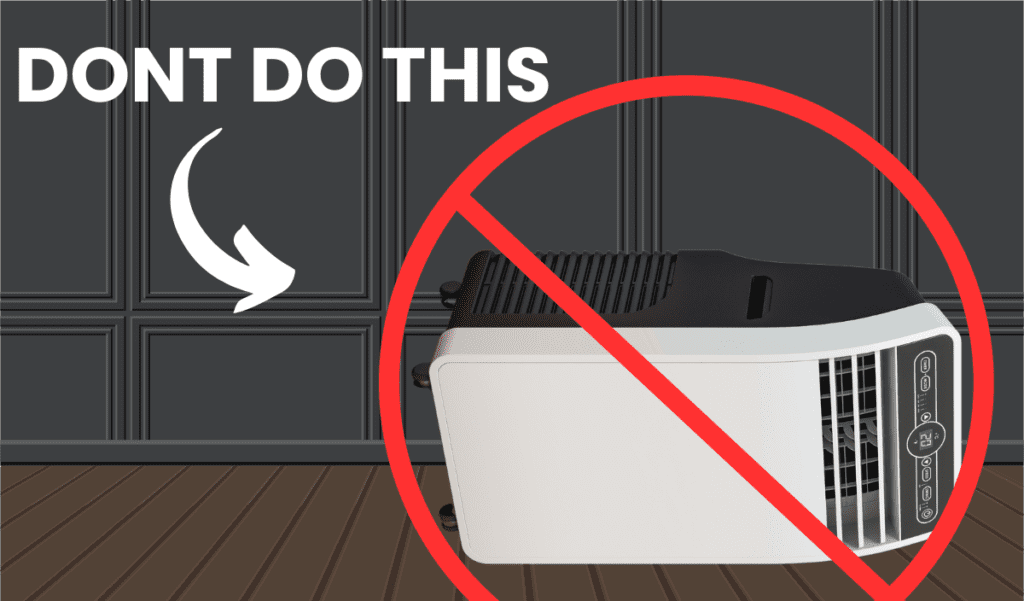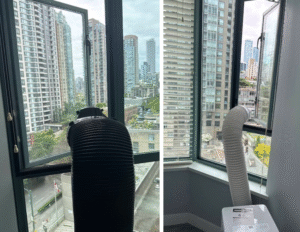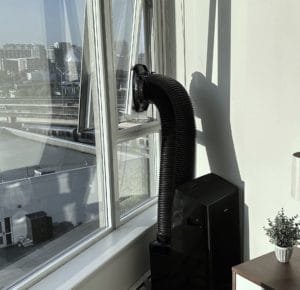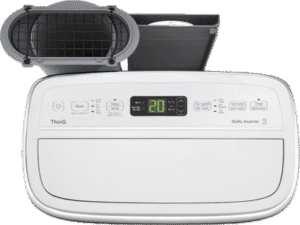If you’re reading this, you’re likely wondering “can a portable ac be laid on its side?”. This is a valid question, and we’ve done the research to provide you with the answers. In this article, we’ll break down three reasons why you should never lay your portable AC unit on its side.
Main Takeaways
- Why you should never have your portable AC laid down
- Correct ways to transport a portable ac
- Proper ways to store your portable AC unit
There are many reasons why someone might lay their portable AC unit on its side, whether it’s for transporting, storing, or inspecting it. However, regardless of the reason, this is NEVER a good idea.
While there are several risks associated with this, we will focus on the three most important reasons why you should avoid doing it.
1. Refrigerant Damage
Portable air conditioners are made to work while standing upright. Inside the portable ac unit, there’s a refrigerant that flows through the system.
What is Refrigerant?
This refrigerant help to cool the air. When a portable ac unit is laid on its side, what that does is it allows the refrigerant to move to areas it is not supposed to which can cause many other issues with the portable ac.
Think of spilling a liquid on something like your computer or another type of device. It can cause parts to stop working properly. Some of the issues that can be caused by this liquid moving to areas it shouldnt be in is
- Poor cooling performance: the air conditioner can stop working as efficiently
- Long-Term System Damage: Components that rely on the refrigerant can become damaged and fixing it can be expensive.
2. Compressor Malfunction
The compressor is the heart of your portable AC. In other words, it’s the part that helps cool the air. The compressor needs oil to stay lubricated, just like a car engine. This oil is designed to sit in a specific position when the unit is upright.
When you lay the unit down, the oil can move or pool in the wrong place. Here’s why this is a problem:
- Overheating: Without proper lubrication, the compressor can get too hot, leading to overheating or total failure.
- Expensive Repairs: Fixing or replacing a damaged compressor can cost almost as much as a new unit.
Imagine tipping over a refrigerator and expecting it to work perfectly. It’s the same idea here.
3. Voiding Your Warranty
Most portable air conditioner manufacturers include a specific warning in the user manual: Do not lay the unit on its side. This isn’t just a suggestion. It’s there because they know how much damage it can cause.
If you ignore this and lay the unit flat, the company may:
- Refuse to Cover Repairs: If you try to claim a warranty repair, they’ll likely deny it because the damage was caused by misuse.
- Leave You Responsible: You’ll be on the hook for fixing or replacing the AC yourself, which can be costly.
It’s like ignoring the “fragile” label on a box and then blaming the manufacturer when something inside breaks.
How do I store my portable AC unit then?
When it comes to tucking your portable AC unit away for the winter, we highly recommend storing it upright in a location that is cool, dry, and out of direct sunlight. Additionally, you can add an extra layer of protection by purchasing a portable AC cover.
Steps to Properly Store Your Portable AC:
Clean Your Portable AC Unit:
- Empty the water tank to prevent mold or mildew buildup.
- Clean the filters to remove dust and debris that can clog the unit.
- Wipe down the exterior with a damp cloth to remove dirt or grime.
Detach Attachments:
- Remove any attachments, such as the exhaust hose or window kit.
- This prevents wear and tear over time, as these parts can deteriorate and may need replacement if not properly stored.
How Portable AC units should be transported
To transport a portable air conditioner safely, start by turning it off and unplugging it. Drain the water tank completely to prevent leaks, and remove any detachable parts. Secure loose items, including the power cord and wheels, to keep them from moving. Always keep the unit upright, as laying it on its side can cause internal damage to the refrigerant or compressor (as mentioned above). Wrap the unit in a blanket or protective cover to avoid scratches, and place it securely in your vehicle, using straps or bungee cords to keep it from tipping. If the AC was tilted during transport, allow it to stand upright for 24 hours before turning it on to let the internal components settle properly.
Frequently Asked Questions:
No, portable AC units should always be transported in an upright position. Laying the unit on its side can cause the refrigerant and compressor oil to shift, leading to damage or reduced performance. If it must be laid down temporarily, allow it to sit upright for at least 24 hours before turning it on.
Before storing your portable AC, make sure to:
- Drain the water tank completely.
- Clean the air filters and wipe down the exterior.
- Remove any detachable parts like the exhaust hose and store them separately. Always store the unit upright in a cool, dry place away from direct sunlight.
If your portable AC was tipped over, stand it upright immediately and leave it in that position for at least 24 hours. This allows the refrigerant and compressor oil to settle back into place. Do not turn it on until this waiting period has passed, as using it prematurely could cause damage.







